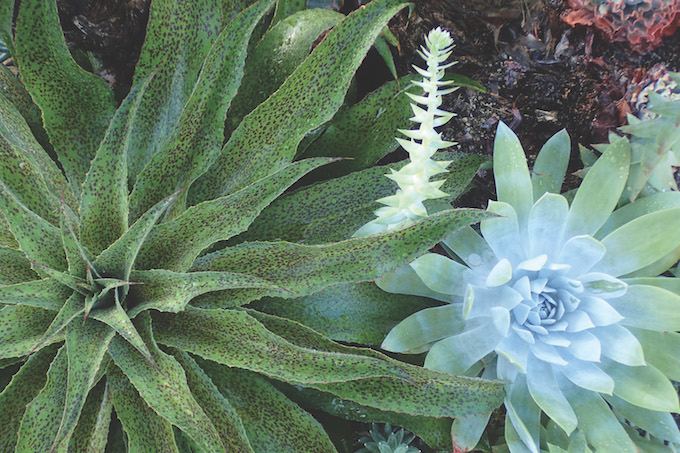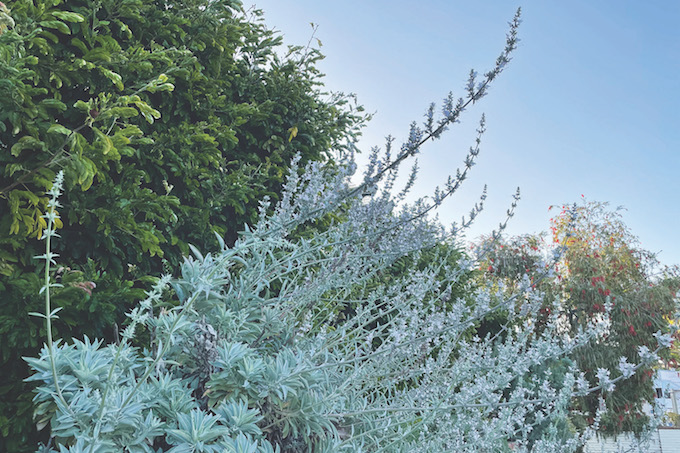
As the perennial drought continues, more Southern California residents swap their lawn for landscaping that needs less water.
By Sarah J. Hemadi
A quick drive around Orange County reveals yard after yard filled with lush, tropical foliage and bright green lawns that require plenty of irrigation. But as water becomes more scarce, gardens will begin to drastically change whether we like it or not.
In 2014, after California recorded the driest year in history, the governor declared a statewide emergency and the continuing drought cycle has hit the landscape hard. This past April, the Metropolitan Water District of Southern California ordered residents in the most populated areas of LA, OC, San Diego, Riverside, San Bernardino and Ventura counties to water their lawns and gardens no more than once a week.

For residents in this region, the seemingly never-ending drought is here to stay—at least for the foreseeable future. And the only choice is to let lawns turn brown as water restrictions are imposed or go green by getting rid of water-guzzling plants.
Eliminating or reducing turfgrass and instead turning to xeriscaping—using proper, drought-tolerant California native plants—might be the answer to the problem, according to Kyle Cheesborough, the horticulture director at Sherman Library & Gardens in Corona del Mar.
A Need for Change
Each time California goes through a drought cycle, the needle moves a bit further toward landscaping that’s more appropriate given the available resources, according to Ron Vanderhoff, general manager and vice president of Roger’s Gardens in CdM. Indeed, sustainable gardening has become more widely accepted over the past several years, resulting in a shift to water-wise landscaping and more efficient irrigation systems.
“The perspective people are embracing is that a drought in California is not an anomaly, it is normal,” Vanderhoff says. “A California garden, if it is well designed and thoughtfully planned, should incorporate some resiliency in the face of expected and normal cyclical droughts. Gardens should be designed and planned with droughts built in, even if created in a nondrought period. It is all about accepting drought as a part of our climate, and acting appropriately with that in mind.”

News about climate change and even the COVID-19 pandemic have also pushed people to adapt to a more eco-friendly lifestyle, Vanderhoff says.
“Several factors have combined over the past decade or so to bring more sustainable approaches to the mainstream,” Vanderhoff says. “Global climate changes are certainly a leading component of this change in attitude, as are pesticides’ residues on foods, biodiversity challenges, invasive organisms, loss of open space and so on. In an odd way, I even think the COVID pandemic opened people’s eyes to the importance of embracing nature.”
Many Benefits
While some homeowners might be concerned about the costs of switching over to more sustainable landscaping, these types of gardens are often budget friendly and save time when it comes to maintenance.
In fact, locals are now being offered incentives to replace grass lawns with California native plants through the Municipal Water District of Orange County’s Turf Removal Program, which provides rebates starting at $3 per square foot of turf removed at a residence; this money can be used to offset the cost of plants that uses less water. Free customized design assistance and maintenance plans are also available. Rebates of up to 50 cents per square foot are offered for switching from spray watering systems to drip irrigation, too. Further cost savings will be realized with lower water bills as climate-appropriate landscape uses 50% to 70% less water than a lawn, according to the district.

And there are plenty of plants to choose from, so homeowners don’t need to feel limited when designing their yards as more than 800 water-sipping plant species are native to OC’s Mediterranean climate.
For those who may be hesitant, Vanderhoff reassures homeowners that sustainable gardens offer many benefits. “My garden is 70% California native plants,” he says. “I do not have a gardener. I water most of the garden perhaps once a month. I use no pesticides and only a modest amount of fertilizers. And I do not spend much time at all on trimming, hedging, weeding, raking and fussing. When drought cycles hit, it has little if any impact on me, my garden or my wallet. I know I spend way less on my garden than most of my neighbors.”
Additionally, fewer weeds may develop in the warm months when a garden is filled with native plants because they require less water—which means less water for the weeds, too. Of course, come wintertime, some weeds may sprout up due to the rainfall.
“Summer weeds are almost always associated with well-watered non-native gardens,” Vanderhoff says. “What’s also interesting is that virtually 100% of the ‘weeds’ that we deal with in our landscapes are also non-native plants from far-away parts of the world. They are non-native weeds invading non-native gardens. This is also true for pests. … Some predicament, non-native pests feeding on non-native plants.”
On the other hand, native plants have very few pests, are self-sustaining and also provide food and shelter for beneficial wildlife such as native birds and pollinators like butterflies, which can be a welcome addition to any yard. Indeed, for these many reasons, adding native plants is a great way to start switching over to a sustainable garden.
“I always suggest that people just starting out with California natives stick with a few of the tried-and-true easiest, then grow—pun intended—into others as they gain experience,” Vanderhoff says.
What to Plant
Some of Vanderhoff’s favorite starter plants, which blend well with others often already in the garden, include red-flowered buckwheat (Eriogonum grande rubescens); foothill penstemon (Penstemon heterophyllus), with blue to purple flowers; and narrow-leaved milkweed (Asclepias fascicularis), which blooms in clusters of cream-colored flowers and is almost a requirement in any garden of native plants since monarch butterfly caterpillars feed on it. But there are many more options as well.
“Deer grass (Muhlenbergia rigens) is a terrific native grass for texture and structure in a garden,” Vanderhoff continues. “California buckwheat (Eriogonum fasciculatum) is one of the very best plants for native pollinators. And toyon (Heteromeles arbutifolia)—[which produces bright red berries]—is easy to work with and especially good for wildlife habitat. That’s a good start and there are dozens more.”

Certain species are easier to keep alive. For example, California buckwheat grows relatively quickly—reaching maturity in a year or two—and is recommended by Lori Whalen, assistant director at the Environmental Nature Center in Newport Beach.
“California buckwheat is green year-round and is the host plant for at least a dozen species of butterflies—and its flowers attract numerous pollinators,” Whalen says, adding that employees at native plant nurseries should be able to recommend options that are easy to grow. She also often turns to calscape.org, managed by the California Native Plant Society, to research plants.
When it comes to Whalen’s own yard, bladderpod, Cleveland sage, white sage, California sagebrush, white flowering currant, coral bells and snowberry have proven to be hassle free. “Basically, my native yard is good to go now that it is established,” Whalen says. “I no longer need to water. I just trim things once a year.”
Laying the Groundwork
When switching over to a sustainable garden, Whalen suggests using mulch as a ground cover to help retain moisture in the soil. “It also helps make it easier to weed and makes a garden look more aesthetically pleasing,” she says. “I use a ‘forest floor’ mulch, which has shredded bark pieces … [up to 1.5 inches long] in most of my garden. In places where I have even drought-tolerant ‘desert’ species—where I have prickly pear [cactus], palo verde, ocotillo, agave, etc.—I use decomposed granite as mulch, accented with partially buried rocks in different sizes.”
Whalen also uses decomposed granite to form trails in her backyard, to better define the borders of her planters. “These trails look neat and clean, give the eyes a place to ‘rest’ and are easy to maintain as well,” she says.
Homeowners may also want to consider composting their yard waste, coffee grounds and kitchen scraps, then adding this nutrient-rich material into their soil or on top as a type of mulch, which mediates soil temperature, conserves water and nourishes beneficial microorganisms.
“Composting is a wonderful way to keep organic materials on-site, improve soil health and even save money,” Vanderhoff says, adding that it can also avoid “carbon miles” associated with transporting all this green waste to recycling facilities and then transporting the finished product back to the gardener who might purchase compost.

To be even more environmentally friendly, homeowners should avoid using chemical weed killers. One way to prevent weeds that try to pop up is by laying down biodegradable weed block fabric (not the plastic types) with compost or mulch on top. “I once utilized the burlap bags from a nearby coffee roasting plant—destined for the dumpster—as biodegradable weed suppressing fabric,” Cheesborough says.
When it comes to watering, some may think drip irrigation is the way to go, directing water right to the plants, but Vanderhoff says this isn’t always the best idea in home gardens with complicated blends of different plant species in small spaces or areas that might be replanted frequently. He prefers sprinkler systems, when done correctly.
“The issue with overhead spray irrigation isn’t so much the spray part, it is the rate at which the water is being applied,” he says. “If overhead sprinklers are switched to super low-flow heads, which deliver the water extremely slowly, it can be a very efficient and water-conserving approach. And overhead water, if properly applied and scheduled, usually produces healthier, more resilient plants.”
For those without a big outdoor area, container gardening is a great way to start incorporating sustainable practices into the space they do have.
“Like many Southern Californians, my home gardening is restricted to my patio,” Cheesborough says. “However, I grow container plants that require very little water or are watered only during their growing season. Most of my collection are bulbs or bulblike plants—collectively referred to as geophytes—that are often able to tolerate very dry conditions for long periods of time.”
So whether a yard is big or small, with these tips and ideas for sustainable gardening, local homeowners can get growing without harming the environment.
Well-Planted
Kyle Cheesborough, horticulture director at Sherman Library & Gardens, suggests these native plants that will thrive in local gardens.

White sage, also called bee sage (Salvia apiana): With a native range restricted to Southern California, bee sage is perfectly suited for the Newport Beach area. Doing well in full sun and the toughest of conditions, Salvia apiana is a pollinator magnet, frequently drawing myriad butterflies, moths, bees and other insects. The species name “apiana” refers to the numerous carpenter bees and bumblebees visiting the plant’s white-lavender flowers.

Brittlebush (Encelia farinosa): A common small shrub in Southern California, brittlebush features bright yellow, daisylike flowers in spring and are a regular stop for pollinating insects. The silvery-white foliage is covered in hairs that act as a protective layer from intense full sun, while also helping to conserve water loss from the leaves.
Manzanita (Arctostaphylos): Widespread and numerous throughout California, many species of native manzanitas are some of the most prolific bloomers and act as host plants for numerous butterflies and moths. Additionally, manzanita plants have flowers with very minute openings, often requiring “buzz pollination” to access the pollen hidden within. Native bee species land on the flower and use their secondary flight muscles to vibrate—at up to 30 times the force of gravity—and dislodge pollen, gathering it as it tumbles from the flower.






